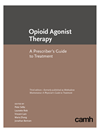Text adapted in 2023 from "Opioid Use and Opioid Use Disorders" in The Primary Care Addiction Toolkit. Available online only.
Importance of managing opioid withdrawal
Managing withdrawal is an essential first step in the treatment of opioid use disorder. Patients with opioid use disorder who have severe physical dependence often continue to use opioids, primarily to avoid withdrawal symptoms. This carries a high risk of overdose and death.
Clinical features of opioid withdrawal
Opioid withdrawal occurs when a person stops or significantly reduces their opioid use after heavy and prolonged use. It may also occur when an opioid antagonist is administered after a period of opioid use. Opioid withdrawal involves a constellation of symptoms and signs that are opposite to the acute agonist effects. It may include:
- flu-like physical symptoms: nausea or vomiting; diarrhea; myalgias; sweating, piloerection or pupillary dilation; lacrimation or rhinorrhea; yawning; fever and insomnia
- psychological symptoms: dysphoria, cravings, insomnia, irritability, agitation, restlessness
- other physical symptoms: tachycardia, increased blood pressure.
Duration and severity of opioid withdrawal
The onset of withdrawal symptoms is related to the half-life of the particular opioid (American Society of Addiction Medicine [ASAM], 2020). For short-acting opioids, symptoms begin within six to 12 hours after last opioid use, peak within 24–48 hours and reduce over three to five days. For long-acting opioids, such as methadone, withdrawal symptoms appear within two to four days of last use and can persist for 10 days. Cravings, insomnia and dysphoria can last for weeks or months.
Opioid withdrawal scales can help to diagnose the severity of withdrawal and monitor how symptoms are responding to clinical management. The most common tool is the Clinical Opioid Withdrawal Scale (COWS), which rates 11 symptoms and signs of opioid withdrawal.
Risks associated with opioid withdrawal
Unlike alcohol withdrawal, opioid withdrawal is not life threatening and does not cause seizures, arrhythmias, delirium or psychosis. However, it does pose other significant risks.
- Pregnant people who go into moderate to severe opioid withdrawal are at risk of miscarriage (first trimester) or premature labour and intrauterine fetal demise (third trimester).
- Infants born to someone who is physically dependent on opioids are at risk for neonatal withdrawal. The severity of neonatal abstinence syndrome or neonatal opioid withdrawal syndrome is related to the timing of last opioid exposure and type of opioid use, as well as to parent and infant metabolism.
- People experiencing opioid withdrawal are at risk for suicide and overdose. The dysphoria associated with opioid withdrawal places patients at risk for suicide during withdrawal, particularly if it is sudden, untreated and forced (e.g., in correctional settings) and if the patient cannot access opioids to relieve withdrawal. This is a particular risk among people with unstable mental health issues.
- Withdrawal symptoms include cravings that can lead to relapse to opioid use.
- Due to loss of tolerance, patients who have gone through opioid withdrawal are at high risk of overdose and overdose death if they relapse to their previous dose after a short period of abstinence.
Strategies for managing opioid withdrawal
Opioid withdrawal generally requires supportive measures (adequate hydration and nutrition, safe environment and reassurance) and pharmacological treatment. There are two pharmacological options: alpha-2 adrenergic agonists and opioid agonists (ASAM, 2020; Miller et al., 2018).
Withdrawal management with alpha-2 adrenergic agonists
Alpha-2 adrenergic agonists (e.g., clonidine) combined with adjunctive medications reduce withdrawal symptoms such as lacrimation, rhinorrhea, myalgias and gastrointestinal symptoms. Clonidine reduces severe withdrawal and improves treatment retention. Most protocols suggest using clonidine at doses of 0.10.3 mg orally every four to six hours. Use clonidine with caution because it carries a risk of hypotension. Adjunctive medications can improve some withdrawal symptoms. They include loperamide for diarrhea, acetaminophen or nonsteroidal anti-inflammatory medications for myalgias and diphenhydramine for nausea and vomiting.
Withdrawal management with opioid agonists
Withdrawal management with opioid agonist medications uses methadone or buprenorphine to reduce withdrawal symptoms and engage patients in care. This approach involves titrating methadone or buprenorphine to suppress withdrawal symptoms, followed by a slow taper. There is limited evidence on the duration of opioid agonist tapers, but care can be individualized to reflect each patient’s needs and circumstances.
Effectiveness and safety of withdrawal management
Methadone and buprenorphine are more effective than clonidine in reducing opioid withdrawal symptoms and retaining patients in care. Buprenorphine is as effective as methadone in reducing withdrawal severity, improving treatment retention and maintaining opioid abstinence.
Withdrawal management that does not include ongoing treatment is not recommended due to the risk of relapse, overdose and overdose death. The standard of care is maintenance with opioid agonist therapy along with psychosocial treatment.
Withdrawal management is not recommended in pregnancy. The recommendation is maintenance with methadone or buprenorphine in an integrated comprehensive treatment program (e.g., Toronto Centre for Substance Use in Pregnancy at St. Joseph’s Health Centre, Sheway or FIR Square programs in Vancouver).
For more details about withdrawal management protocols, see the ASAM National Practice Guideline for the Treatment of Opioid Use Disorder.


